SENSUIKAN!
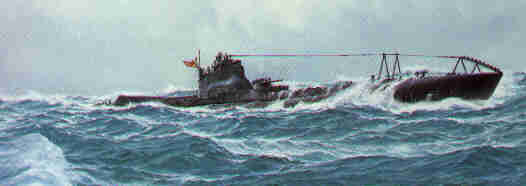
Midget Submarines at Pearl Harbor,
Hawaii
1941
© 2006-2017 Bob Hackett and Sander Kingsepp
Revision 4
10 October 1940:
The first batch of ten Type
A midget submarines (Nos. 3 to 12) is ordered from the Karasu-Kojima
Torpedo Factory.
15 November 1940:
The midget submarine is accepted into IJN service as
"Type A improved ASW target" (Ko-Hyoteki). That same day, a group of 13
officers and petty officers arrives aboard Captain (Vice Admiral, posthumously)
Harada Kaku's (41)(former CO of HOSHO) CHIYODA for classroom training in midget
submarines, directed by Cdr (Rear Admiral, posthumously) Kato Ryonosuke (48).
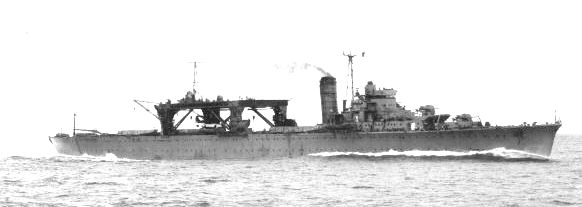 CHIYODA 1938
January -March 1941:
CHIYODA 1938
January -March 1941:
The first group undergoes sea training and
further instruction.
April 1941:
Training of the first group is completed. A second group
of ten officers and 12 petty officers and ratings arrives and begins training.
Sea training is conducted aboard CHIYODA and Captain (later Rear Admiral)
Komazawa Katsumi's (42)(former CO of CHOGEI) newly commissioned
seaplane/submarine tender NISSHIN. Only two officers of all the midget
submariners are volunteers; the rest are routinely assigned the duty.
May 1941:
Mitsukue Bay (Ehime Prefecture), off Shikoku. The second
group of trainees simulates attacks on anchored vessels. Tug KURE MARU serves
as temporary base.
June-July 1941:
Seaplane tender CHIYODA undergoes a modification to
her stern to form a ramp to enable her to launch midget submarines.
18 August 1941:
The second group conducts its final exercise, using
CHIYODA as the target. During a subsequent conference, some crewmembers suggest
use of the new weapon to penetrate enemy naval bases to attack capital ships.
They also suggest the use of "mother" submarines as midget carriers to overcome
the midget submarines' short range problem. Soon thereafter, training of the
second group is completed.
Early September 1941:
Naval General Staff (NGS) liaison officer Cdr
(Rear Admiral, posthumously) Ariizumi Tatsunosuke (51) inspects CHIYODA. Captain
Harada informs him of the harbor-penetrating concept and asks that Ariizumi
forward the idea to the NGS. Harada, Lt Iwasa Naoji (65) and Lt(j.g.) Matsuo
Keiu (66) compile several studies about attacks on naval bases at Pearl Harbor,
San Francisco, Hong-Kong, Singapore and Sydney.
Late September 1941
Aki Nada, Inland Sea. To verify the feasibility
of penetrating an enemy harbor with midget submarines, Captain Harada conducts
a series of night exercises in Hirajo Bay, Shikoku. The midget submariners
operating from Captain (later Rear Admiral) Furukawa Tamotsu's (43)(former CO
of KAMOI) seaplane/submarine tender CHITOSE practice attacking a defended
harbor that, unknown to them, resembles Pearl Harbor and returning to the unlit
CHITOSE at night.
4 October 1941:
A planning conference is held aboard the Combined
Fleet's temporary flagship battleship MUTSU, concerning the details of the
forthcoming attack on Pearl Harbor. Captain Harada appeals to C-in-C Admiral
(Fleet Admiral, posthumously) Yamamoto Isoroku (former CO of AKAGI) to use the
midget submarines in parallel with the air attack. Admiral Yamamoto suggests
Harada reconsider his idea and report back to him the next day.
5 October 1941:
Captain Harada, accompanied by Lt Iwasa and Lt(j.g.)
Matsuo, returns to MUTSU. The junior submariners plea directly to Admiral
Yamamoto to permit the use of midget submarines in the Hawaii Operation. Most
air staff officers vehemently oppose the idea.
11-13 October 1941:
Hashirajima. At another planning conference aboard
the Combined Fleet's flagship battleship NAGATO, Admiral Yamamoto approves the
use of midget submarines in the forthcoming Hawaii Operation. Several months
later, the midget submarine part of the Pearl Harbor attack is designated as
"Shinki"(Divine Turtle") Operation No. 1.
19 October 1941:
Headquarters, Sixth Fleet (Submarines) issues an
order to convert five midget submarines and five Type
C-1 mother submarines for the Hawaii Operation. To upgrade the harbor
penetrating capabilities of the midget submarines, they are fitted with a
pneumatically operated steering system. Twenty-five batteries from the forward
battery room are landed and replaced by four additional air bottles for the
steering system. The range at low speed is marginally increased, but the
maximum speed drops to 16 knots. A scuttling charge is fitted into the aft
battery room. All midget submarines are fitted with net guard/cutters, jumping
wires and propeller guards. Running lights are blanked off. A built-in
telephone is fitted to communicate with the mother submarine. All work is
finished by 10 November.
22 October 1941:
Yokohama. The Nippon Yusen Kaisha (NYK) liner TAIYO
MARU departs for Hawaii. Aboard disguised as crew members are three IJN
officers: Cdr (later Rear Admiral) Maejima Toshihide (48), LtCdr Suzuki Suguru
(55) and midget submarine pilot Lt Matsuo Keiu. TAIYO MARU plies the North Pacific
route that will be followed by the Kido Butai carrier striking force in the
Hawaii Operation. [1]
1 November 1941:
Oahu, Hawaii. At 0830, TAIYO MARU arrives at
Honolulu. Lt Matsuo's mission is to reconnoiter the harbor entrance to Pearl
Harbor's naval base.
5 November 1941:
The three IJN officers depart for Japan aboard TAIYO
MARU.
14 November 1941: - The Hawaii Operation:
Headquarters, Kure Naval
District. Vice Admiral Shimizu Mitsumi (36), C-in-C, Sixth Fleet (Submarines)
and his chief of staff, Captain Mito Hisashi (42) lead a staff conference. Fleet
submarines I-16, I-18, I-20, I-24 and I-22 (F) are assigned to Captain (later
Rear Admiral) Sasaki Hankyu's () Special Attack Unit.
Cdr Arima Takayasu (52), the Combined Fleet's senior torpedo staff
officer, briefs Captain Sasaki and the five midget submarine officers of the
Special Attack Unit on the Hawaii Operation. According to the battle plan, the
midget submarines will be employed only in case the major part of the U.S.
Pacific Fleet is stationed at Pearl Harbor anchorage. The midget submarines
have to attack in the lull between the two air strikes and arrive at the
rendezvous point 7 nms ESE of Lanai Island on 8 December.
17 November 1941:
Yokohama. TAIYO MARU arrives. Cdr Maejima and Cdr
Suzuki provide an intelligence briefing to the top officers of the NGS's
headquarters. Afterwards, Cdr Maejima and Lt Matsuo rush to the Kure Navy Club
and arrive just in time to brief the midget submarine crews' officers on Pearl
Harbor's defenses.
18 November 1941:
Early in the morning, the Special Attack Unit
departs Kure for the Kamegakubi Naval Proving Ground. At Kamegakubi each of the
unit's submarines embarks a top-secret two-man Type A midget submarine. In the
evening, the last conference is held, led by Cdr Ariizumi.
19 November 1941:
At 0215, all five of the Special Attack Unit's
submarines depart for the Hawaiian Islands. Lt Matsuo, whose intelligence
duties precluded him being designated a midget submarine CO for the operation,
is aboard I-22 as XO of the Special Attack Unit. While at sea, the enlisted
midget submariners are briefed on the Hawaii Operation. The mother submarines
use a direct route, but pass Wake and Midway islands at 600-mile distance to
avoid detection by aircraft.
2 December 1941:
The coded signal "Niitakayama nobore (Climb Mt.
Niitaka) 1208" is received from the Combined Fleet. It signifies that
hostilities will commence on 8 December (Japan time).
7 December 1941 (Local): The Attack on Pearl Harbor:
Submarines I-68 and I-69 are ordered to lay off the entrance to Pearl
Harbor to rescue midget submarine crews.
At 0042, I-16 launches Lt(j.g.) Yokoyama Masaji (67) and PO2C Ueda
Sadamu's midget submarine HA-16 about seven miles SSW of the harbor's entrance.
M-16 is the first of five midget submarines released by the Special Attack
Unit.
At 0116, I-22 launches Lt Iwasa Naoji (one of the two volunteers) and
PO1C Sasaki Naokichi's HA-15 about nine miles from the harbor's
entrance.
At 0215, I-18 launches Lt(j.g.) Furuno Shigemi and PO1C Yokoyama
Shigenori's HA-17 from about 13 miles from the harbor's entrance.
At 0257, I-20 launches Ensign Hiroo Akira and PO2C Katayama Yoshio's
HA-18, 5.3 miles from the harbor's entrance.
At 0333, I-24 launches Ensign Sakamaki Kazuo and PO2C Inagaki Kiyoshi's
HA-19, 10.5 miles WSW of the harbor's entrance. HA-19 begins to broach, but
Inagaki manages to correct the trim successfully.
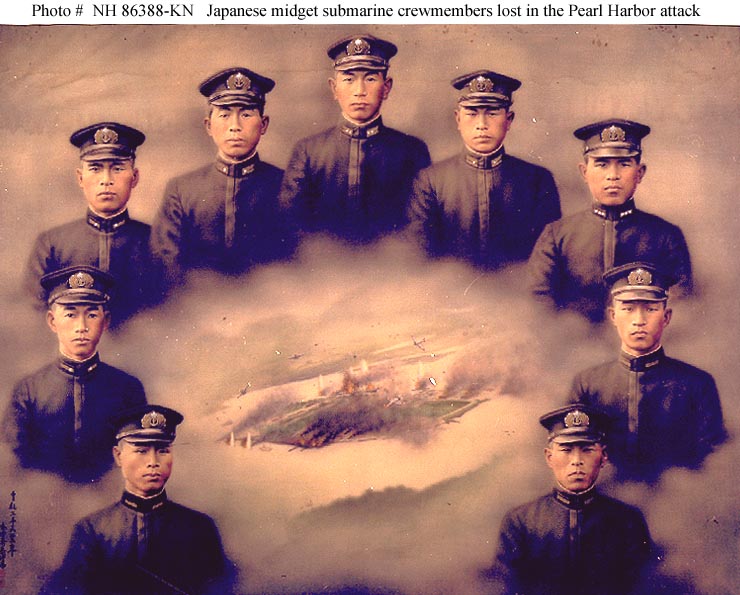 Pearl Harbor Midget Submariners [2]
(Naval Historical Center)
At 0408, LT W. W. Outerbridge's old USS WARD (DD-139) begins a search for
a suspected submarine reported by minesweeper CONDOR (AMC-14), but finds
nothing. At 0630, as Training Squadron 8's flagship 8 USS ANTARES (AKS-3)
approaches Pearl's outer gate with a target raft in tow, WARD's lookouts spot a
small conning tower. A patrolling PBY "Catalina" flying-boat 14-P-1, flown by
Ensign William P. Tanner of Patrol Squadron VP-14, drops smoke markers on the
contact.
At 0645, WARD opens fire at 100 yards. Her first round - the first shot
fired in WWII by American Forces - misses. She closes to point blank range (50
yards) and fires a 4-inch shell, hitting the midget submarine's conning tower.
WARD overruns her target and the midget submarine wallows in her wake.
Outerbridge orders four depth charges dropped. At 0651, he signals 14th Naval
District Headquarters:
"WE HAVE ATTACKED FIRED UPON AND DROPPED DEPTH CHARGES
Pearl Harbor Midget Submariners [2]
(Naval Historical Center)
At 0408, LT W. W. Outerbridge's old USS WARD (DD-139) begins a search for
a suspected submarine reported by minesweeper CONDOR (AMC-14), but finds
nothing. At 0630, as Training Squadron 8's flagship 8 USS ANTARES (AKS-3)
approaches Pearl's outer gate with a target raft in tow, WARD's lookouts spot a
small conning tower. A patrolling PBY "Catalina" flying-boat 14-P-1, flown by
Ensign William P. Tanner of Patrol Squadron VP-14, drops smoke markers on the
contact.
At 0645, WARD opens fire at 100 yards. Her first round - the first shot
fired in WWII by American Forces - misses. She closes to point blank range (50
yards) and fires a 4-inch shell, hitting the midget submarine's conning tower.
WARD overruns her target and the midget submarine wallows in her wake.
Outerbridge orders four depth charges dropped. At 0651, he signals 14th Naval
District Headquarters:
"WE HAVE ATTACKED FIRED UPON AND DROPPED DEPTH CHARGES
UPON SUBMARINE OPERATING IN DEFENSIVE SEA AREA."
The PBY drops more depth bombs. A midget submarine, thought by some
researchers to be Hiroo and Katayama's HA-18, is sunk.
At 0700, Sakamaki’s midget submarine HA-19 makes the harbor entrance, but
cannot enter the harbor before the air strike commences.
At 0755, the Striking Force's first wave of 189 aircraft attack the Naval
Base at Pearl Harbor and other military installations on Oahu, Territory of
Hawaii.
About 0800, Sakamaki surfaces, but runs aground on a reef. HA-19's gyro
compass malfunctions and Sakamaki has to expose his periscope frequently for
navigation. At 0817, HA-19 is spotted by USS HELM (DD-388) that opens fire on
the midget submarine and misses, but HA-19's lower torpedo tube, net
guard/cutter and vertical rudder are damaged by the collision with the reef.
Inagaki shifts lead ballast bars aft of batteries while Sakamaki runs full
power astern. HA-19 slips off the reef. Later, the midget submarine's batteries
exude chlorine gas that knocks the crew unconscious. When Sakamaki comes to, he
sees smoke from ships burning in the harbor.
 Battleship Row under Air Attack
(U. S. Navy)
Battleship Row under Air Attack
(U. S. Navy)
During the air attacks, the Striking Force sinks battleships ARIZONA (BB-39),
OKLAHOMA (BB-37) and CALIFORNIA (BB-44) and damages NEVADA (BB-36),
PENNSLYVANIA (BB-38), TENNESSEE (BB-43), MARYLAND (BB-46), WEST VIRGINIA
(BB-49) and other smaller ships.
HA-19 runs aground again. Sakamaki and Inagaki shift ballast and free the
midget submarine, but it will not answer the helm. Drifting, HA-19 is depth
charged several times. Sakamaki tries to beach her, but runs aground again. He
lights the fuse of the midget submarine's self-destruct charge and leaps into
the surf where he is battered unconscious again and washes ashore on Waimanalo
Beach near Bellow's Field. The scuttling charge does not explode. Both of
HA-19's torpedoes are found intact aboard the midget submarine. [3]
 Location where Sakamaki and Inagaki's HA-19 was found
(Scanned from H.P. Willmott's "Pearl
Harbor")
At 0830, LtCdr William P. Buford's USS MONAGHAN (DD-354) is attempting to
sortie from Pearl Harbor via the North Channel to evade the on-going air raid
when nearby destroyer/minesweeper USS ZANE (DMS-14) reports "sighted enemy
submarine 200 yards astern of MEDUSA." Minelayer BREESE (DM-18) spots the
midget submarine next, followed by seaplane tender CURTISS (AV-4) that opens
fire.
At 0837, MONAGHAN spots the submarine's periscope and part of its conning
tower about 1,200 yards off her starboard bow. LtCdr Buford orders flank speed
and prepares to ram. In the meantime, repair ship USS MEDUSA (AR-1) and tender
TANGIER (AV-8) open fire on the midget submarine.
The submarine fires a torpedo at CURTISS, but broaches and is hit by a
5-inch shell fire from the tender that probably decapitates her skipper. The
midget submarine is also raked by .50 cal. machine-gun fire. Her torpedo misses
CURTISS and hits a dock. MONAGHAN bores in on the submarine. The midget turns
into the destroyer and fires its last torpedo. It just misses to starboard and
explodes against the shore of Ford Island. MONAGHAN rams the midget submarine
and pushes her down to the bed of the 30-foot deep harbor. The destroyer then
drops two depth charges that blow the midget submarine to the surface. The
midget submarine sinks NW of Ford Island.
A midget submarine, possibly Furuno and Yokoyama's HA-17, is depth-charged
and sinks in the Keehi Lagoon just off Pearl Harbor.
Location where Sakamaki and Inagaki's HA-19 was found
(Scanned from H.P. Willmott's "Pearl
Harbor")
At 0830, LtCdr William P. Buford's USS MONAGHAN (DD-354) is attempting to
sortie from Pearl Harbor via the North Channel to evade the on-going air raid
when nearby destroyer/minesweeper USS ZANE (DMS-14) reports "sighted enemy
submarine 200 yards astern of MEDUSA." Minelayer BREESE (DM-18) spots the
midget submarine next, followed by seaplane tender CURTISS (AV-4) that opens
fire.
At 0837, MONAGHAN spots the submarine's periscope and part of its conning
tower about 1,200 yards off her starboard bow. LtCdr Buford orders flank speed
and prepares to ram. In the meantime, repair ship USS MEDUSA (AR-1) and tender
TANGIER (AV-8) open fire on the midget submarine.
The submarine fires a torpedo at CURTISS, but broaches and is hit by a
5-inch shell fire from the tender that probably decapitates her skipper. The
midget submarine is also raked by .50 cal. machine-gun fire. Her torpedo misses
CURTISS and hits a dock. MONAGHAN bores in on the submarine. The midget turns
into the destroyer and fires its last torpedo. It just misses to starboard and
explodes against the shore of Ford Island. MONAGHAN rams the midget submarine
and pushes her down to the bed of the 30-foot deep harbor. The destroyer then
drops two depth charges that blow the midget submarine to the surface. The
midget submarine sinks NW of Ford Island.
A midget submarine, possibly Furuno and Yokoyama's HA-17, is depth-charged
and sinks in the Keehi Lagoon just off Pearl Harbor.
About 0840, a second wave of 171 aircraft attacks the Naval Base By 0945,
they retire towards their carriers.
Captain George A. Rood's ST. LOUIS (CL-49), steaming at 25 knots, is the
first major unit to reach open water. At 1004, as she stands by the first
entrance buoy to the South Channel, a midget submarine fires two torpedoes from
2000 yards on her starboard beam. Both miss, but only because they ground on a
reef to the west of the dredged channel.
At 2241, I-16 is patrolling west of Lanai, Hawaii when she receives a
"Se, se, se!” (short for seiko, or success, success, success) message about the
successful air attack. Some researchers think it may have come from Lt
Yokoyama's midget HA-16, but it may well have come from any of the midget
submarines because the reception was very poor.
8 December 1941:
At 0051, I-16 receives another message thought by
some to be from Yokoyama that says "unable to navigate." All five of the
Special Attack Unit's midget submarines fail to return to their "mother"
submarines.
That same day, Ensign Sakamaki is taken prisoner - the first POW taken by
the United States in the Second World War.
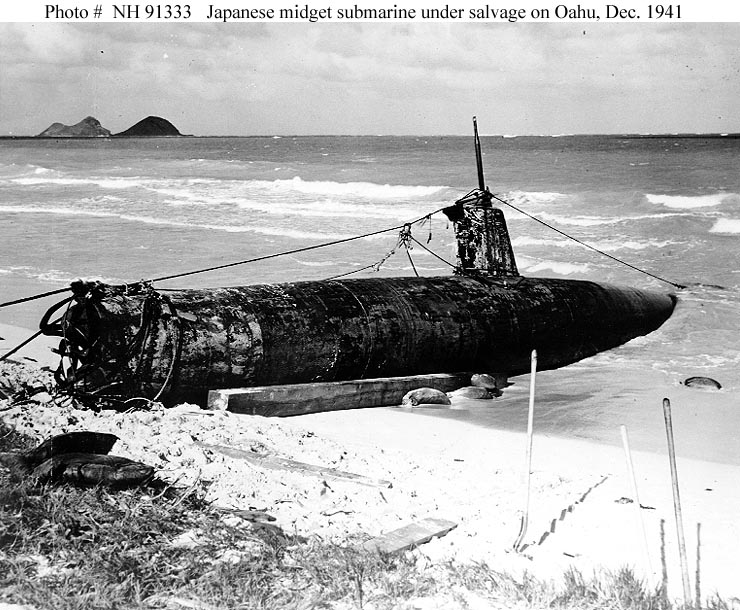 Sakamaki and Inagaki's Beached Type A Midget Submarine HA-19
(U. S. Navy)
December 1941:
Sakamaki and Inagaki's Beached Type A Midget Submarine HA-19
(U. S. Navy)
December 1941:
A midget submarine, identified by some researchers as
Lt Iwasa's HA-15, is raised about two weeks after the attack. A No. 1 dress
blues sleeve with rank insignia of a full Lieutenant was found floating in the
harbor. It may have belonged to Iwasa or one of the downed Japanese pilots.
Iwasa was the only officer of that rank in the midget submarine attack force.
The sleeve is returned to the Japan by the U.S. Navy in March 1947 and has been
on display at the Yasukuni Shrine, Tokyo since 1972. Some Japanese researchers
theorize that HA-15 was the midget submarine that tried to torpedo CURTISS and
was rammed and sunk by MONAGHAN, however, this identification is speculative.
The hulk of the raised midget was salvaged, but was in such a bad shape that no
one entered it. Her screws and net guard/cutters were salvaged and used in the
reconstruction of HA-19. The remainder of the wreck was dumped during the S-1
submarine dock reconstuction at Ford Island. It was rediscovered in 1952, but
reburied at the same place because chlorine gas had eaten away all its
contents. The remains of the crew are still inside.
6 March 1942:
The crews of all the Pearl Harbor midget submarines,
except PoW Sakamaki, are posthumously promoted two ranks.
21 May 1944: The Second Pearl Harbor Disaster:
West Loch anchorage,
Pearl Harbor. At 1508, an explosion of Landing Ship Tank LST-353 wracks the
amphibious staging area sinking six LSTs readying to sail to the Marianas
Islands for the invasion on Saipan, codenamed "Operation Forager."
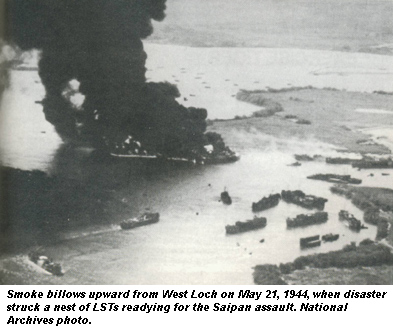 West Loch Anchorage Disaster
The blast appears to have originated near the bow of LST-963, where Army
troops were unloading heavy mortar ammunition. Fragments shower the clustered
LSTs, igniting gasoline drums lined up on them. Each LST carries trucks, jeeps,
and weapon carriers on their main decks, all of which are loaded with
ammunition and gas. Each vessel also carries 80 to 100 drums of high-octane
fuel on its forecastle. Six thousand cubic feet of ammunition are stowed on the
deck with field guns and amphibious craft known as DUKWs. Explosions begin to
rip the invasion fleet apart. In all, six LSTs are sunk and several severely
damaged. 163 men are killed and 396 wounded. The disaster becomes one of the
Navy's best-kept wartime secrets.
The United States LST Association's website gives more details on the
West Loch disaster at:
http://www.uslst.org/archive_second_pearl_harbor.htm
13 June 1960:
West Loch Anchorage Disaster
The blast appears to have originated near the bow of LST-963, where Army
troops were unloading heavy mortar ammunition. Fragments shower the clustered
LSTs, igniting gasoline drums lined up on them. Each LST carries trucks, jeeps,
and weapon carriers on their main decks, all of which are loaded with
ammunition and gas. Each vessel also carries 80 to 100 drums of high-octane
fuel on its forecastle. Six thousand cubic feet of ammunition are stowed on the
deck with field guns and amphibious craft known as DUKWs. Explosions begin to
rip the invasion fleet apart. In all, six LSTs are sunk and several severely
damaged. 163 men are killed and 396 wounded. The disaster becomes one of the
Navy's best-kept wartime secrets.
The United States LST Association's website gives more details on the
West Loch disaster at:
http://www.uslst.org/archive_second_pearl_harbor.htm
13 June 1960:
A midget submarine is discovered in the Keehi Lagoon in
only 75 feet of water.
6 July 1960:
The Keehi Lagoon midget submarine is raised by the
submarine rescue ship USS CURRENT (ARS-22). No human remains are found aboard.
The conning tower hatch is open. Inside the midget submarine the remains of a
flightsuit, one flying boot, a single glove, rubber-soled sandal, an empty
bottle of sake, several wrenches and spanners are found. Based on this
evidence, some researchers identify that midget as Lt(j.g.) Furuno's HA-17.
The forward section is found to contain both torpedoes intact. The
section is unbolted and it and the torpedoes therein are disposed of at sea.
Much later, the entrance to Keehi Lagoon is covered by the extension of
Honolulu International Airport's runway. At the request of the Japanese
Government, the remainder of the midget submarine is returned to Japan. A new
forward section is fabricated and the midget submarine is now at the Naval
Tactical School No. 1 at Etajima, Hiroshima, another of the four Type A midget
submarines on display around the world.
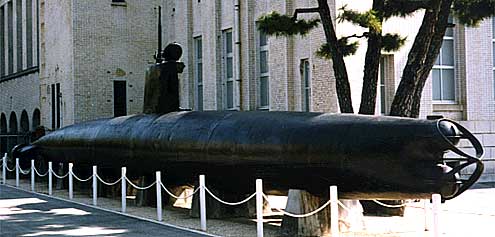 Pearl Harbor Type A at Etajima
August 1966:
Pearl Harbor Type A at Etajima
August 1966:
Suga Park, Mitsukue Bay, Ehime Prefecture. The pilots of
the midget submarines that attacked Pearl Harbor trained at the submarine base
at Mitsukue Bay which has geographical characteristics similar to Pearl Harbor.
Seto Town erects a monument to honor the nine men who died in the attack on
Pearl Harbor.
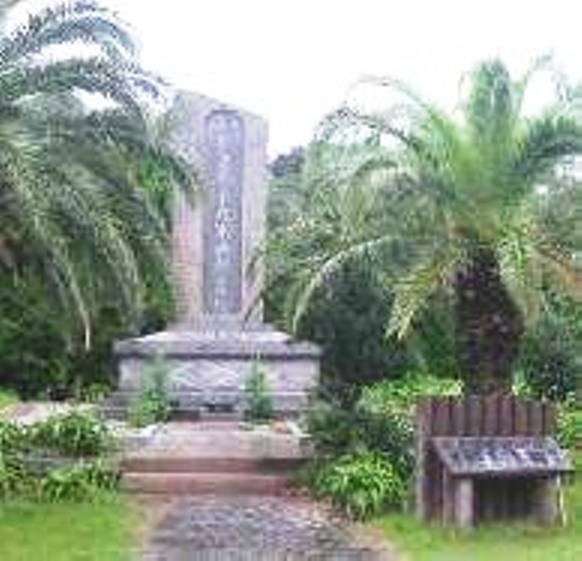 Nine War Gods Monument at Suga Park
27 July 1992:
Nine War Gods Monument at Suga Park
27 July 1992:
A team from the University of Hawaii’s Undersea
Research Laboratory (HURL), in the deep-submersible vehicle PISCES V locates
the aft section of a Type A midget submarine 1200 feet down in the Defensive
Sea Area several miles off Pearl. Postwar, this area became a dumping ground
for hundreds of items of obsolete or discarded war materials, such as landing
craft, tanks, old aircraft, trucks, barges, small ships, fuel tanks etc. The
aft section is located in this field with other debris. Unfortunately, PISCES
V's tracking system is malfunctioning and cannot provide reliable coordinates
to the surface. As a result, the location of the aft section of this Type A is
temporarily "lost". [4]
5 September 2000:
PISCES V locates the mid-section of a Type A midget
submarine at 1200 feet in the Defensive Area. The mid-section is missing about
15 feet aft of the conning tower, possibly caused by the submarine's scuttling
charges. A survey of this section indicates that it most probably was dumped
here. [4]
9 November 2000:
Famed Wood's Hole Oceanographer and undersea
explorer Bob Ballard's deep-water remote-operated imaging vehicle ARGUS lights
up the remains of a Type A midget submarine in the Defensive Area dumping
ground. Only its mid-section and sail remains. This mid-section is the same one
HURL found two months earlier. It is theorized that this midget submarine had
been captured in another campaign, possibly Guam, studied by intelligence
experts at Pearl, then dumped. [4]
29 August 2001:
PISCES IV is en route to the mid section discovered
the previous fall when the dive team locates the bow-section of a Type A midget
submarine at 1200 feet. The bow is fitted with an early "figure 8" net
guard/cutter. The torpedo tubes are empty. A hole has been punched in forward
part of this bow section to allow a hawser to be attached to drag and dump the
section into the Defensive Area. After filming these two sections the team
continues exploring and "rediscovers" the tail section found nine years
earlier. [4]
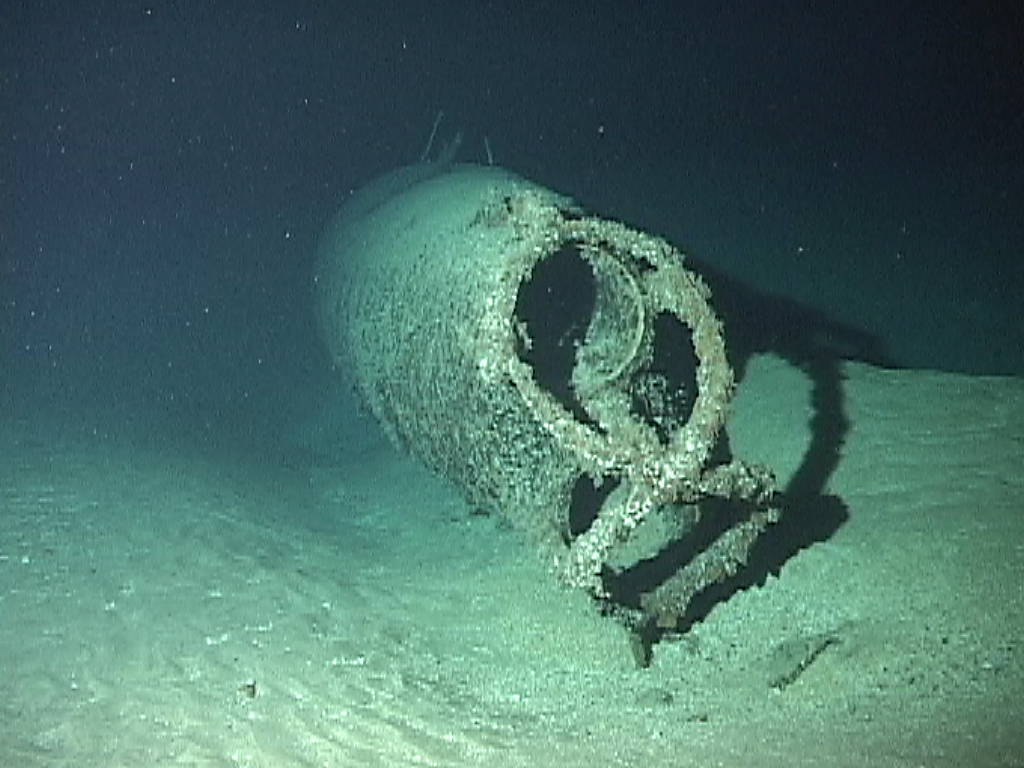
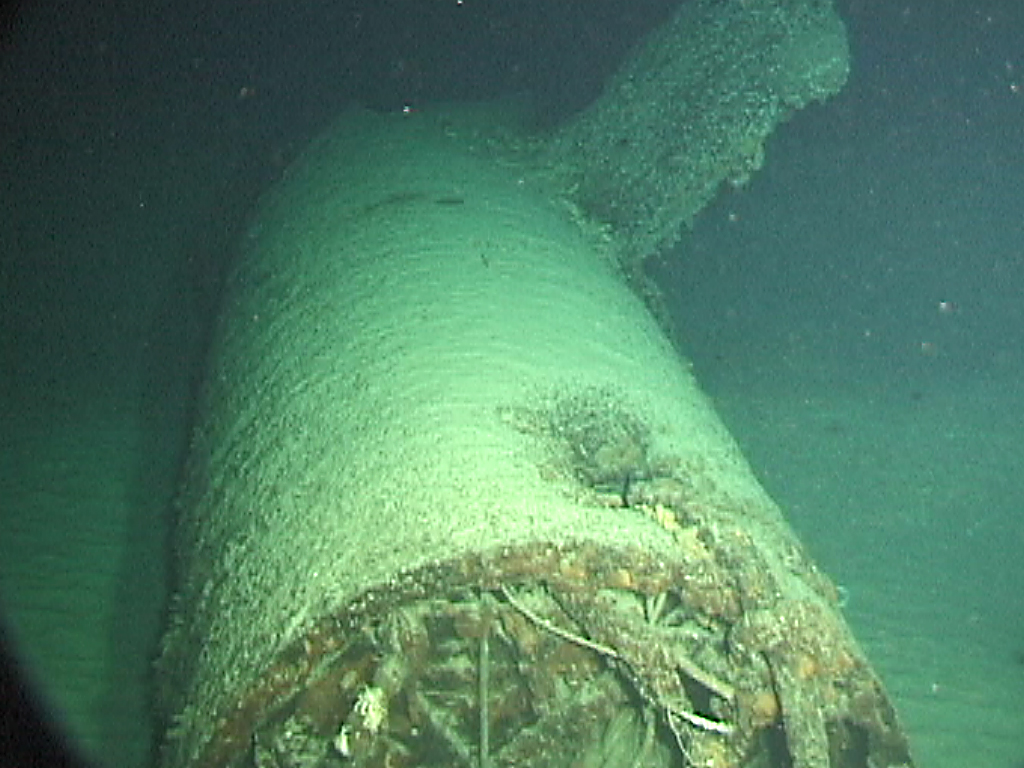
Forward Bow and Mid-sections of Type A
(Hawaii Undersea Research Laboratory)
28 August 2002:
PISCES IV and PISCES V discover a midget submarine in
1,312 feet (400 m) of water five miles off Pearl Harbor. There is a 4-inch hole
in the conning tower and both of her torpedoes are still aboard. This seems to
conclusively prove that this midget submarine is one sunk by USS WARD and
Ens Tanner's PBY. It is thought by some researchers to be Hiroo and
Katayama's HA-18, however, this identification is speculative.
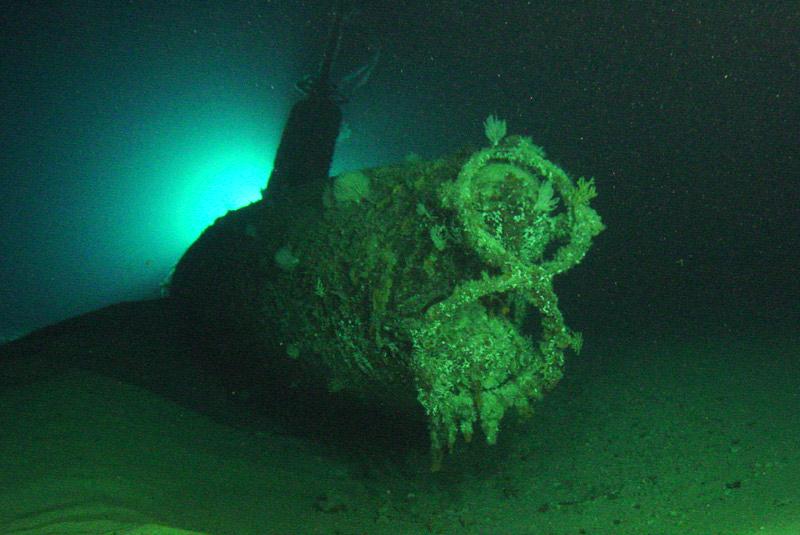

Pearl Harbor Type A found by HURL showing hole in conning tower
(Hawaii Undersea Research Laboratory)
Authors' Notes:
In reality, the HA-type numeration was not used by the IJN
during the Pacific War. HA-numbers are here adopted for convenience. The numbers
for all the Pearl Harbor midget submarines, except Sakamaki and Inagaki's HA-19,
originate from the work of the Japanese historian Katsume Junya (2011).
Attribution by researchers of actions to specific midget submarines, other than
HA-19, is mostly speculative.
[1] Lt Matsuo is later KIA in the attack on Sydney, Australia.
[2] The nine submariners lost at Pearl are from the left: P02C Katayama
Yoshio of I-20, PO1C Sasaki Naokichi of I-22, PO1C Yokoyama Shigenori of I-18,
Ens Yokoyama Masaji of I-16, Lt Iwasa Naoji of I-22, Lt(j.g.) Furuno Shigemi of
I-18, Ens Hiroo Akira of I-20, P02C Ueda Sadamu of I-16 and P02C Inagaki Kiyoshi
of I-24.
Ensign Sakamaki Kazuo of I-24's HA-19, taken prisoner, is not shown in
this Japanese painting. The IJN public affairs department circulated a rumor to
explain the missing crewmember to the effect that Lt Iwasa had led his craft
single-handedly. The IJN credited the midget submarines with sinking USS ARIZONA
13 hours after the air attack.
[3] Since 1991, Sakamaki and Inagaki's midget submarine HA-19 has been
displayed at the Fleet Admiral Chester A. Nimitz "National Museum of the
Pacific War" in Fredericksburg, Texas, one of four such Type A midget
submarines on display around the world.
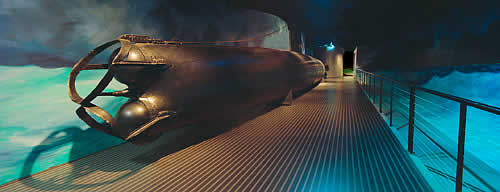 Sakamaki's HA-19 at the National Museum of the Pacific War
MISSING FIFTH MIDGET SUBMARINE FOUND?
[4] All three sections discussed and pictured above when discovered by
HURL in 1992, 2000 and 2001 were found to have been disconnected at the joining
sections, had rigging cables attached and had been scuttled. An approximately
15-foot piece of this midget submarine’s aft mid-section, as shown on the
drawing below, is still missing. This piece is from the jagged end where a
scuttling charge blew the stern off, to where the bolts of the intact part of
the stern section were later cut off with a torch or saw.
Sakamaki's HA-19 at the National Museum of the Pacific War
MISSING FIFTH MIDGET SUBMARINE FOUND?
[4] All three sections discussed and pictured above when discovered by
HURL in 1992, 2000 and 2001 were found to have been disconnected at the joining
sections, had rigging cables attached and had been scuttled. An approximately
15-foot piece of this midget submarine’s aft mid-section, as shown on the
drawing below, is still missing. This piece is from the jagged end where a
scuttling charge blew the stern off, to where the bolts of the intact part of
the stern section were later cut off with a torch or saw.
 Missing M-16?
Missing M-16?
The origin of the three sections of the midget submarine is unknown, but
Terry Kerby, HURL's Director of Operations, has developed a theory that makes
sense. His theory centers on "The Second Pearl Harbor Disaster" discussed above.
Kerby believes the three pieces were discovered during clean up of West
Loch. The civilian salvers probably lifted the two main pieces of the hull
onto a crane barge and disassembled it at its flange joints to make it easier
for disposal. Later, the three pieces were dumped in the Defensive Sea Area,
along with other debris from West Loch.
HURL's investgators verified that the submarine pieces had been
disassembled and rigged with cables for easier handling. The West Loch Disaster
was placed under a veil of secrecy, so there was no record of the salvage and
disposal.
As noted above, the torpedo tubes in the bow-section of the Type A midget
submarine found on 29 August 2001 were empty. HURL's theory is that this midget
fired its torpedoes at Captain (Rear Admiral-Ret) George A. Rood's USS ST. LOUIS
(CA-49) as she exited South Channel out of Pearl Harbor at 22 knots. Both
torpedoes missed and exploded on the reef.
Finally, Rear Admiral Ueda Kazuo (JMSDF-Ret)(a midget submarine commander
and ex-staff member of the Japanese Midget Submarine Association) confirmed that
only the Pearl Harbor midgets had the "figure 8" net guard/cutter over the
torpedo tubes. Thus, there is strong evidence that the three pieces discovered
in the Defensive Sea Area comprise the missing fifth midget submarine. It is
thought by some researchers to be Yokoyama and Ueda's HA-16, however, this
identification is also speculative.
Many thanks go to Steven L. Price of the Hawaii Undersea Research
Laboratory for assistance with this revision.
For further information/speculation about the missing fifth midget
submarine and the three-piece midget submarine, see: I-16tou.
-Bob Hackett and Sander Kingsepp
Back to Submarine
Page



















